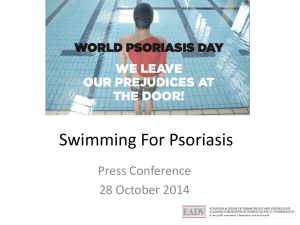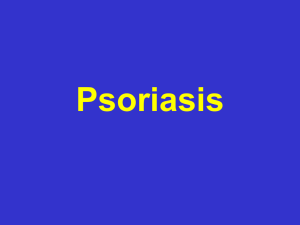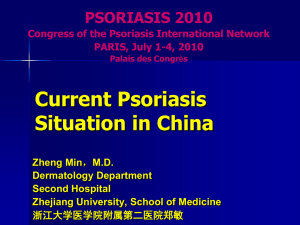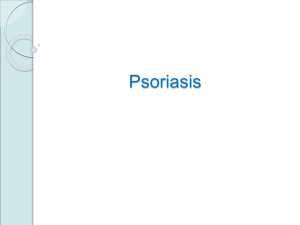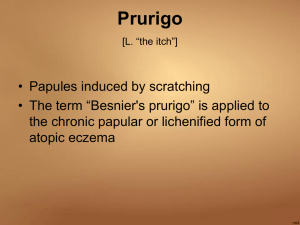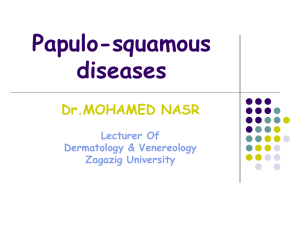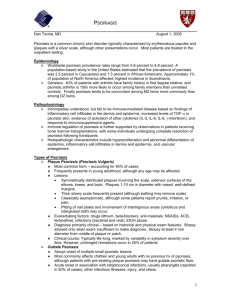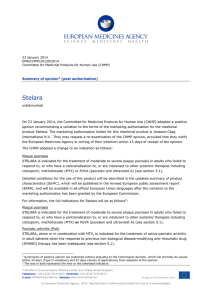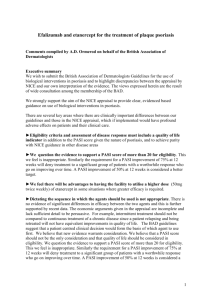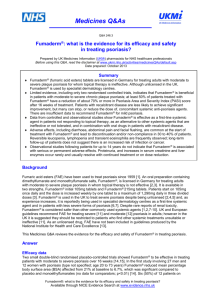View/Open - Hasanuddin University
advertisement
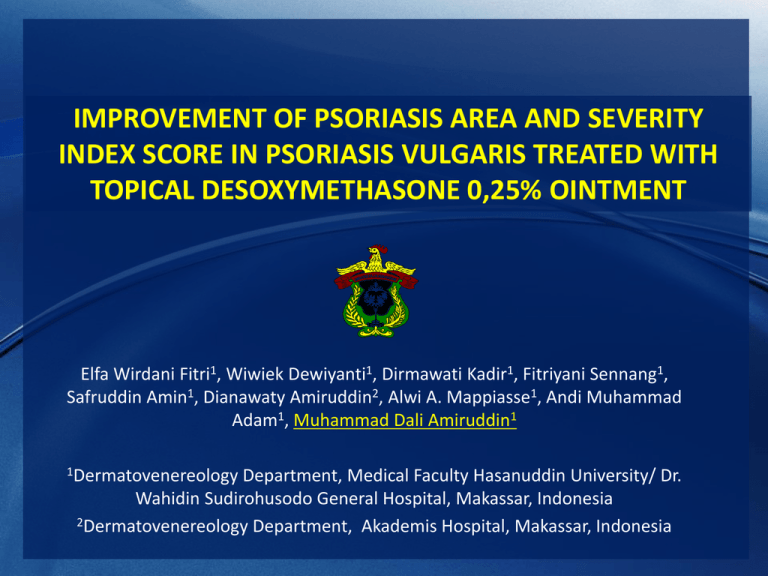
IMPROVEMENT OF PSORIASIS AREA AND SEVERITY INDEX SCORE IN PSORIASIS VULGARIS TREATED WITH TOPICAL DESOXYMETHASONE 0,25% OINTMENT Elfa Wirdani Fitri1, Wiwiek Dewiyanti1, Dirmawati Kadir1, Fitriyani Sennang1, Safruddin Amin1, Dianawaty Amiruddin2, Alwi A. Mappiasse1, Andi Muhammad Adam1, Muhammad Dali Amiruddin1 1Dermatovenereology Department, Medical Faculty Hasanuddin University/ Dr. Wahidin Sudirohusodo General Hospital, Makassar, Indonesia 2Dermatovenereology Department, Akademis Hospital, Makassar, Indonesia INTRODUCTION • Psoriasis is a chronic recurrent inflammatory skin diseases with typical lesions form of patches and demarcated erythema, scale covered by thick layers of shiny white mica • Prevalence : 0,8-11,8% world population • Can occur at any age • Based on a study in the U.S. population, the incidence of psoriasis is highest in the age group of 5 to 6 decades 2 Psoriasis Varian • Plaque psoriasis • Pustular psoriasis • Guttate psoriasis • Inverse psoriasis • Eritroderma psoriasis • Psoriatic arthritis 3 PSORIASIS VARIAN • Plaque psoriasis skin lesions are red at the base and covered by silvery scales • Pustular psoriasis blisters of non infectious pus appear on the skin. Attacks of pustular psoriasis may be triggered by medications, infections, stress, or exposure to certain chemical 4 PSORIASIS VARIAN • Psoriasis guttata small, drop shaped lessions appear on the trunk, limbs, and scalp. Guttate psoriasis is most often triggered by upper respiratory infections • Inverse psoriasis smooth, red patches occur in the folds of the skin near the genitals, under the breast, or in the armpits. The symptoms may be worsened by friction and sweating 5 PSORIASIS VARIAN • Erythrodermic psoriasis widespread reddening and scalling of the skin may be a reaction to severe sunburn or to taking corticosteroids or other medications • Psoriatic arthritis joint inflammation that produces symptoms of arthritis in patients who have or will develop psoriasis. 6 The cause of psoriasis is unknown, Genetic factors may influence the onset of the disease. stress, alcohol consumption, smoking, presence of systemic diseases such as streptococcal infection, HIV, endocrine factors, as well as the discontinuation of corticosteroid therapy abruptly factors as trigger 7 • To measure the severity of psoriasis, use the calculation of body surface area (BSA) involved and the psoriasis area and severity index (PASI). Objective scale or PASI and BSA can be used as a reference for the selection of drug therapy and to assess the response given 8 PASI SCORE I. INTENSITY Redness, Thickness , Scalling (none (0), mild (1), moderate (2), severe (3) or very severe (4) Then add for each region of body A1 as Head and Neck, A2 as Upper limb, A3 Trunk, A4 lower limb • • • • A1 x 0.1 gives B1 A2 x 0.2 gives B2 A3 x 0.3 gives B3 A4 x 0.4 gives B4 9 II. Area The percentage area affected by psoriasis is evaluated in the four regions of the body. In each region, the area is expressed as none (0), 1-9% (1), 13-29% (2), 30-49% (3), 50-69% (4), 7089% (5) or 90-100% (6) • • • • B1 x (0 to 6)= C1 B2 x (0 to 6)= C2 B3 x (0 to 6)= C3 B4 x (0 to 6)= C4 The PASI score is C1 + C2 + C3 + C4 10 CASE REPORT • A 80-year-old man, came with reddish scaly patches, looked dry on the chest, abdomen, back, arms and thighs, accompanied by intense itching. The disorder is experienced since more than 3 years ago. Patients did not remember the initial shape and in which lesions first appear • Patients often went to the doctor and was given ointment (unknown), but the symptoms of redness and itching did not dissapear. Family history was denied. The patient did not complain of pain in the joints. The patient did not smoke and did not consume alcohol 11 • Results of physical examination showed good general condition, awareness compos mentis, and vital signs within normal limits. • Dermatological status of the chest, abdomen, back, arms and thighs, scaly erythematous plaques effloresence demarcated by the shape varies with the size of nummular - plaque. Wax phenomenon and Auspitz sign were positive. PASI score (Psoriasis Area and Severity Index) was 9.6 12 PASI SCORE BEFORE THERAPY I. INTENSITY Redness, Thickness , Scalling (none (0), mild (1), moderate (2), severe (3) or very severe (4) Then add for each region of body A1 as Head and Neck, A2 as Upper limb, A3 Trunk, A4 lower limb • • • • A1 x 0.1 gives B1 0 x 0,1 : 0 A2 x 0.2 gives B2 3 x 0,2 : 0,6 A3 x 0.3 gives B3 4 x 0,3 : 1,2 A4 x 0.4 gives B4 3 x 0,4 : 1,2 13 II. Area The percentage area affected by psoriasis is evaluated in the four regions of the body. In each region, the area is expressed as none (0), 1-9% (1), 13-29% (2), 30-49% (3), 50-69% (4), 7089% (5) or 90-100% (6) • • • • B1 x (0 to 6)= C1 0 B2 x (0 to 6)= C2 0,6 x 4 : 2,4 B3 x (0 to 6)= C3 1,2 x 4 : 4,8 B4 x (0 to 6)= C4 1,2 x 2 : 2,4 The PASI score is C1 + C2 + C3 + C4 0 + 2,4 + 4,8 + 2,4 : 9,6 14 Day 1 Dermatological status of the chest, abdomen, back, arms and thighs, scaly erythematous plaques effloresence demarcated by the shape varies with the size of nummular - plaque. Found wax 15 phenomenon is positive, the Auspitz sign positive Day 1 Dermatological status of the chest, abdomen, back, arms and thighs, scaly erythematous plaques effloresence demarcated by the shape varies with the size of nummular - plaque. Found wax phenomenon is positive, the Auspitz sign positive 16 • Laboratory results (CBC, blood sugar) within normal limits. Liver function within normal limits, creatinine renal function in the upper threshold of normal value • The differential diagnosis of this disease is seborrheic dermatitis and pityriasis rubra pilaris, the working diagnosis was psoriasis vulgaris • Results of histopathological examination showed support a conclusion of psoriasis vulgaris 17 Therapy Desoximetasone ointment 0,25%+salisil acid 3 %+LCD 3 % : 2x / day Simptomatic therapy: mebhydrolin napadisylate 2x50 mg / day and neuroroboransia 2x/day biopsy: eritromisin 3x500 mg / day dan mefenamic acid 3x500 mg/ day 18 DAY 15 The patient showed improvement in the form of plaque thinning, reduced erythema and scaling and itching reduced 19 PASI score 2,3 Topical therapy is continued, the patient is recommended to control regularly 20 PASI SCORE AFTER THERAPY I. INTENSITY Redness, Thickness , Scalling (none (0), mild (1), moderate (2), severe (3) or very severe (4) Then add for each region of body A1 as Head and Neck, A2 as Upper limb, A3 Trunk, A4 lower limb • • • • A1 x 0.1 gives B1 0 x 0,1 : 0 A2 x 0.2 gives B2 1 x 0,2 : 0,2 A3 x 0.3 gives B3 1 x 0,3 : 0,3 A4 x 0.4 gives B4 2 x 0,4 : 0,8 21 II. Area The percentage area affected by psoriasis is evaluated in the four regions of the body. In each region, the area is expressed as none (0), 1-9% (1), 13-29% (2), 30-49% (3), 50-69% (4), 7089% (5) or 90-100% (6) • • • • B1 x (0 to 6)= C1 0 B2 x (0 to 6)= C2 0,2 x 4 : 0,8 B3 x (0 to 6)= C3 0,3 x 1 : 0,3 B4 x (0 to 6)= C4 0,8 x 2 : 1,6 The PASI score is C1 + C2 + C3 + C4 0 + 0,8 + 0,3 + 1,6 : 2,3 22 Discussion • Most people never reach a state of remission-free therapy • Patients with psoriasis (2/3 cases) reported experiencing itching. Characteristic plaques of psoriasis vulgaris in the form of hyperkeratosis, itchy and sometimes sore. • This sensation occurs due to changes in the structure of the epidermis dry and broken in layers that trigger inflammatory • Histopathological picture of psoriasis vulgaris varies, depending on the stage of the lesion is the initial lesions, lesions that developed, and advanced lesions. 23 Discussion • To initiate therapy may use a reference PASI score. PASI score calculation method is to assess the intensity of erythema, thickness and scaling lesions. • Topical corticosteroids have become the primary therapy for many years. Corticosteroids have antiinflammatory, anti-proliferative, immunosuppressive and vasoconstrictor. 24 Discussion • Topical corticosteroids can be used in combination with other topical therapies to increase effectiveness and reduce side effects. • The combination of topical corticosteroids with salicylic acid 3-10% aiming to increase the penetration of corticosteroids, thereby increasing therapeutic efficacy. 25 Discussion • Liquor carbonis detergent (LCD) 2-5% is a distillation of coal is most often used in the treatment of inflammatory skin disease that has been used since long, was originally used for the treatment of psoriasis. • LCD inhibits DNA synthesis and mitosis in epidermal cells, also an antipruritic, anti-inflammatory, antiakantosis keratoplastic, and the photosensitizing effect vasokonstriktif • Reduction of PASI score (Psoriasis Activity and Severity Index)> 50% showed clinically meaningful improvement 26 CONCLUSION • The use of objective scales such as psoriasis area and severity index (PASI) is essential for assassing disease severity before starting therapy and to fascilitate subsequent assessment of response to treatment. • Psoriasis is a complex disease to manage. Although no modality of therapies can cure the disease, several topical therapies can minimize the disease. 27 29 30 Case Reference 31 32
